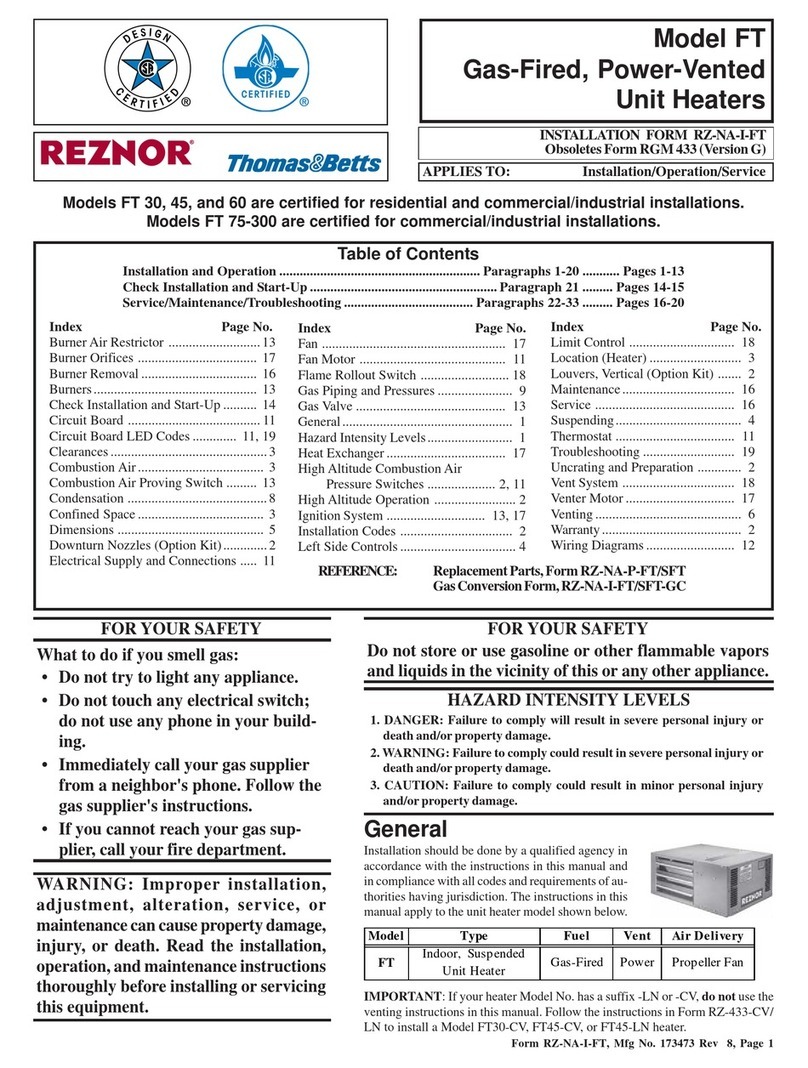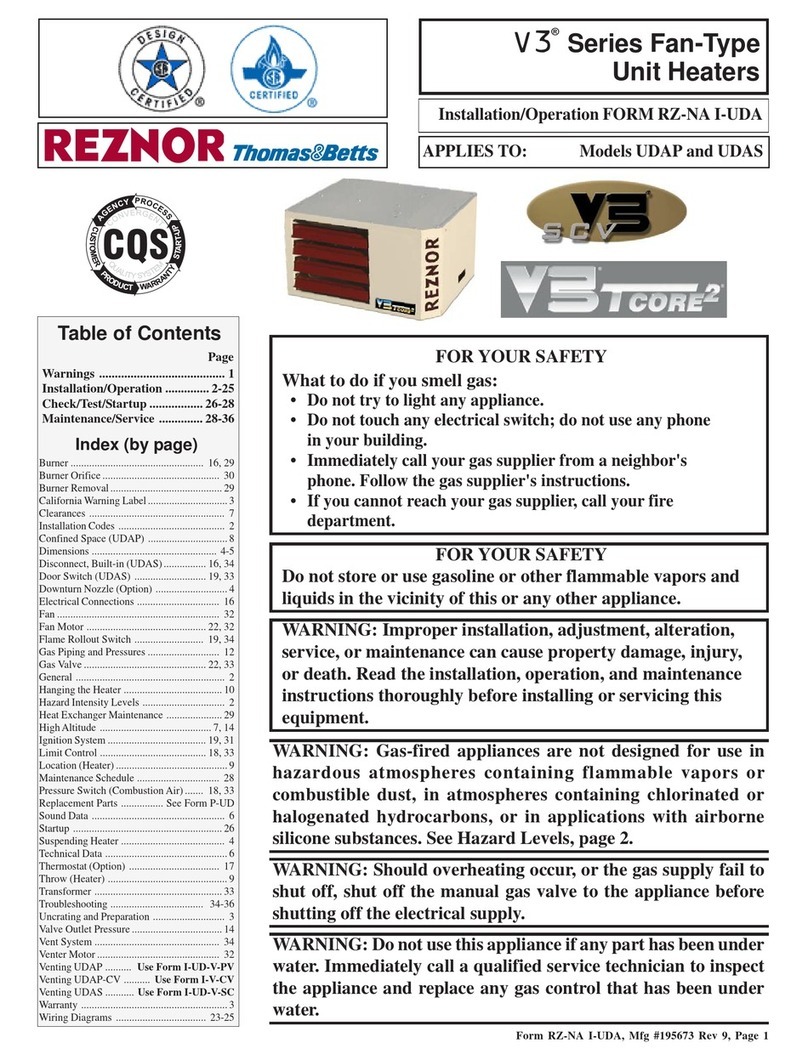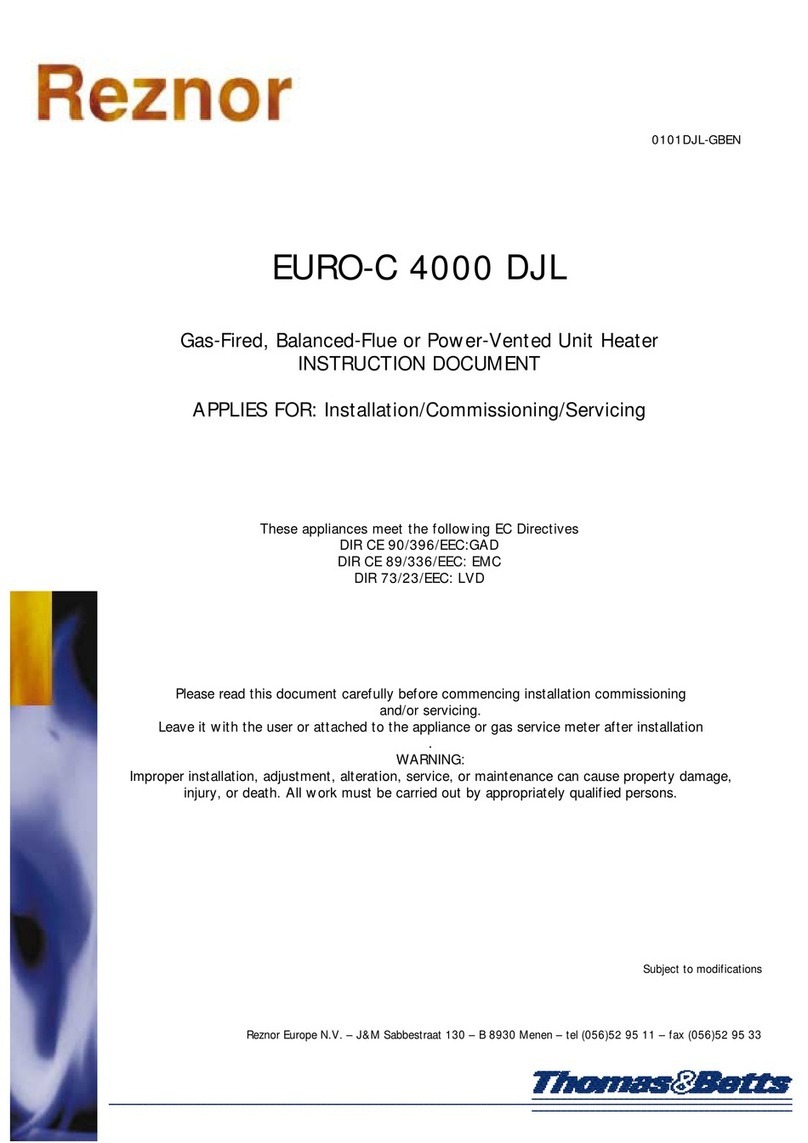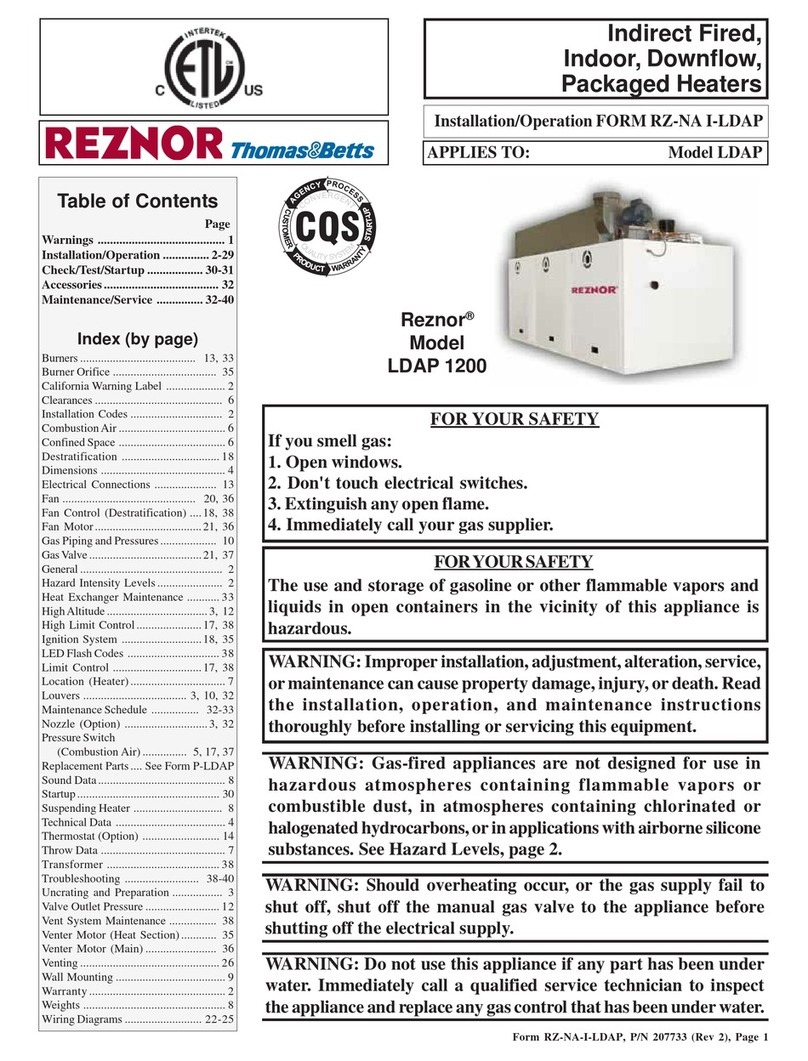
Form RZ-NA-I-TR, Page 4
Tube Cartons - Tubes are also packaged so that a minimum number of
cartons will cover all lengths of heater systems. This package identifica-
tion system applies to all heaters, whether shipped from distributor stock
or shipped to order from the factory. Before beginning installation,verify
thatthe packages at the job site match the length ofheater being installed.
Packaging Scheme for Tubes
Pkg P/N Contents
120294 Combustion ChamberTube; Tail Pipe with Turbulator
120295 Combustion ChamberTube; Heat Exchanger Tube;
Tail Pipe with Turbulator
120296 Heat Exchanger Tube; Heat ExchangerTube with
Turbulator
Tube Packages (left) Required by Length of System
Length Qty Pkg Qty Pkg
20 ft system requires 1 P/N 120294
30 ft system requires 1 P/N 120295
40 ft system requires 1 P/N 120294 1P/N 120296
50 ft system requires 1 P/N 120295 1P/N 120296
60 ft system requires 1 P/N 120294 2P/N 120296
70 ft system requires 1 P/N 120295 2P/N 120296
Reflectors, reflector brackets, and hardware packages are included in
heatingapplications. Referto therecommendedminimummountingheights
below. Use the mounting height, the size ofthe heater, the heater configu-
ration,andtheapplicationconditionstodeterminethemostefficientloca-
tion of the heater.
6. Uncrating/Packaging
Check for shipping damage. If any damage is found,document the dam-
age with the shipping agency and immediately contact your Reznor
Dsitributor.
Because of their modular design, these heaters are packaged in sections
and require field assembly. The burner/control box is in one carton, and
the tubes are packaged in one, two or three cartons depending on the
length of the system.
Burner/ControlBox Carton - For the convenience of both the stocking
and the non-stocking distributor, the burner/control boxes have two dif-
ferent packaging methods. Readcarefullytodeterminewhetherornot
the burner/control box requires field conversion before being in-
stalled.
(1) Burner/Control Box Packages
Package Contents
TR50 Factory-assembled Size 50,000 BTUH heater
TR75/100 Factory-assembled Size 75,000 BTUH heater
Conversion kit to change to a Size 100,000 BTUH heater
TR125/150 Factory-assembled Size 125,000 BTUH heater
Conversion kit to change to a Size 150,000 BTUH heater
TR175/200 Factory-assembled Size 175,000 BTUH heater
Conversion kit to change to a Size 200,000 BTUH heater
(2)Burner/ControlBoxFactoryBuiltto a Specific Size - If the burner/
controlboxcartondoesnot have a label about field conversion, the carton
contains a burner/control box factory-built to a specific size. Check the
rating plate to verify size and type of gas.
5. Location and Mounting
Height (cont'd)
Clearancetocombustiblesmustbeobserved(SeeParagraph 4), includ-
ing clearances to stock that might be periodically stacked underneath
theheater.
The supporting structure must have a load-carrying capacity of at least
200 lbs.
Do not locate the heater above or too close to electric lines, gas pipes,
emergency sprinkler systems, or any such structures that could be
adversely affected by radiant or convection heat.
Donotlocatethe heater where it could be damaged byhighlifts,cranes,
or any other such equipment.
Since chain suspension is required to allow for expansion and contrac-
tionof the tubes, proper positioning near large door openings is impor-
tant.Iftheheater is being installed near alargedoor(ex:garage, loading
dock,aircrafthangar,etc.),position the heater so that it willnot"swing"
inthe wind. Lateral movement of the tubular system should be limited.
(2) Comfort
Because of the unique heat transfer features of an infrared heater, the
comfort quality of the heat is greatly affected by the location of the
heater. Rays of heat are emitted from the surface of the tubes and
directedbythereflectors.Whenradiantheatraysreachasurface,those
rays are absorbed, raising the temperature of that "object". Since infra-
red heat does not heat the air, a comfort advantage is that stratification
does not occur. When the rays are not obstructed from reaching the
floor, the floor and lower level areas maintain a more comfortable
temperature than with convection (warm air) heating equipment.
For optimum comfort when infrared heaters are being used to "heat"
personnel (spot heating), it is recommended that (1) the rays of heat be
directed toward the person(s) from an angle rather than from directly
overhead, and (2) the heater(s) be arranged so that rays are directed
against at least two sides (or front and back) of the person(s). If the
heater must be hung directly overhead, a higher mounting height will
increasethecomfortlevelbecause the greater distance will decrease the
intensity level of the rays. Another significant factor when locating
the heater in relation to people is that the heat emitted from the
burner/combustionchamber end of the tubularinfrared heater is
moreintense than the heat emitted from the exhaustend. For this
reason, a U-tube configuration is often best suited for overhead
spot heat applications.
Tubular radiant heaters are engineered to provide comfort-level per-
sonal spot and space heating, but each application should be designed
individuallyto determine the best, quality-comfort locations.
(3)Efficiency
Because of the unique features of radiant heat transfer, selecting the
most efficient location for infrared equipment depends on the "floor"
coverage of the emitted heat rays. Floor coverage distance can be fig-
uredasapproximatelytwotimes the mounting height of the unit. How-
ever,comfort levelheating depends on the infrared intensity, and inten-
sity levels decrease with higher mounting heights and greater floor
coverage. For more accurate measurement, consult the manufacturer's
flux density tables.
Forspaceheatinginfrared applications, the location of theunitsmustbe
evaluatedaspartoftheheatersizeselection.DeterminethetotalBTU's
required, the floor coverage required, and the mounting height. From
thisinformation design a heater size and location plan that will provide
the most complete floor coverage without excessive overlapping. In
mostcases,perimeterheatersshouldbe located parallel to the wall. The
distance from the wall is determined by whether the reflectors will be
angled or horizontal.
For spot heating applications, the tubular system should be located to
direct the rays toward the area requiring heat. Depending on the instal-
lation,thiscan be done from directly overhead or reflector angled from
the side. U-tube configurations are often best suited to overhead spot
RecommendedMinimum Mounting Height
Reflector Size (000BTUH Input)
Position 50 75 100 125 150 175 200
feet 11 12 13 15 16 17 18
M3.4 3.7 4.0 4.6 4.9 5.2 5.5
feet 9 101113141516
M2.7 3.0 3.4 4.0 4.3 4.6 4.9
feet 8 9 10 11 13 14 15
M2.4 2.7 3.0 3.4 4.0 4.3 4.6
Horizontal
30° Angle
45° Angle
































